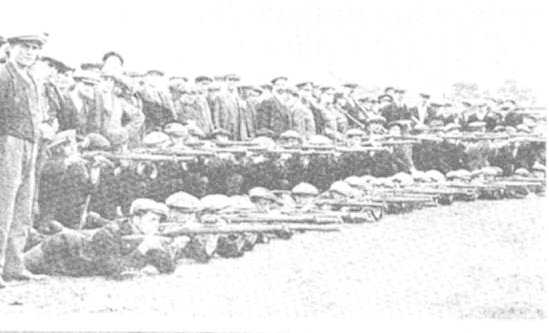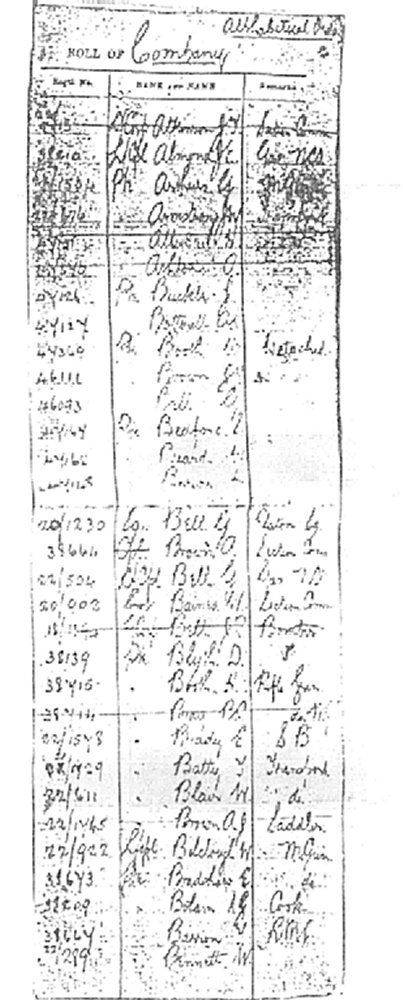|
In December 1914 Brigadier-General Trevor Ternan, CB, CMG, DSO was
recalled from retirement to command the new unit. At this time the
men were training, mainly in civilian clothes, in and around
Newcastle itself. The 1st and 2nd Battalions were in the city, the
3rd was at Newburn and the 4th at Gosforth. Drilling was carried out
in the streets of Newcastle, the men being mainly in civilian clothes
and carrying broom handles to represent rifles.
Officers for the New Army were obtained from a number of sources.
Some 500 officers from the Indian Army were home on leave, and these
were dispatched to various units more or less at random. The War
Office had drawn up a list of 2,000 young men, most of whom had
recently left university or public school, as being suitable junior
officers, and invitations to volunteer for commissions were sent to
these. This still left a huge gap in the supply of officers, as each
new battalion needed over 30. The number was made up by bringing men
out of retirement, such as Brigadier-General Ternan. Some of these
men had seen active service as recently as the Boer Wars of 14 years
earlier, but others had been retired much longer. At least one such
officer had seen action in the Ashanti War of 1873.
The Tyneside Scottish Battalions were commanded at first by Lt-Col
C H Innes-Hopkins (1st Batt.); Col V M Stockley (2nd Batt.); Lt-Col A
P A Elphingstone (3rd Batt.); and Capt J C Campbell (4th Batt.). Over
the ensuing months some of the commanding officers changed, but
Lt-Col Elphingstone remained with the 3rd Battalion, and led it at
the Battle of the Somme.
The problems which now beset the newly formed Brigade were no
different to those being experienced all over the country.
Overwhelmed by the rush of volunteers, the Army was unable to cope.
Ex-Regular NCOs were recruited and formed the basis of the NCOs in the new unit. The Regimental Depot then turned to the War Office
with demands for advice, ration money, equipment and, above all,
instructors. The replies, when they came, generally consisted of
little more than terse orders to "Carry On".
Obviously, the present arrangements for billeting of the Tyneside
Scottish were far from satisfactory, and so it was decided to move
the Brigade to a hutted camp specially constructed in the Duke of
Northumberland's Park at Alnwick. Accordingly, on 29th January 1915
the 1st Battalion route marched from Newcastle, halting for the night
at Morpeth and arriving at Alnwick the following day. Brigade
Headquarters moved on 1st March, and the 2nd Battalion on the 12th
March. The remaining two Battalions followed a little later.
Meanwhile, the question of uniform was being addressed. At first,
the Battalions adopted a variety of tartans, but as some doubt was
expressed as to the legality of this, a new tartan was designed and
adopted by the whole Brigade. A cap badge was also designed, and this
incorporated both Scottish and Tyneside elements. The design had been
submitted by a junior officer of the 4th Battalion. The men of the
Brigade did not wear the kilt, but instead wore trews in the Brigade
Tartan. The headdress adopted was the Glengarry. In addition to the
Brigade uniform, every soldier was equipped with the basic
infantryman's kit, which amounted to about one third of his own
weight. Each Battalion was entitled by regulation to a small pipe
band, and these were equipped by the Tyneside Scottish Fund, each
uniform costing some £30. The pipers themselves had been
recruited on the basis of their musical skill, and some leeway was
allowed regarding age. Pipe-Sergeant Barton was well over 40, and had
three sons serving in the Brigade's pipe bands.

Recruits learning to handle rifles
At Alnwick the Brigade settled into the routine of serious
military training. The Park itself was used for drill, and there were
rifle ranges a few miles away. The moorland in the area later
provided ground in which trench digging could be practised, and also
area for attack and defence exercises. The men were taught to dig and
build the 'ideal' trench, six feet deep with parapets of sandbags to
absorb rifle bullets, fire steps for sentries, and duckboards over
drainage channels. At intervals along the trenches were dugout
shelters to afford some protection from the weather. Life was not all
work, as the men were also engaged in various sporting activities,
and were able to return home occasionally on weekend leave.
On 20th May 1915 the Brigade achieved official recognition when it
was inspected on Town Moor, Newcastle, by HM King George V,
accompanied by Lord Kitchener. The Brigade had been taken into the
city by train and several other Brigades were also on parade. All in
all the King inspected some 18,000 troops. As the unit was still not
fully kitted out, it was loaned some rifles which were said to have
come from the Tower of London. Whether that was true or not, as soon
as the parade was over they were collected in and dispatched
elsewhere. One result of this inspection was that His Majesty
suggested to Ternan that the Brigade exchange its Glengarries for
Balmorals, as these gave better shade to the eyes. Kitchener agreed
and told the Commanding Officer to send in the necessary request.
This Ternan did on the following day, but it was several months
before supplies eventually arrived.
In the following month the Tyneside Scottish was designated as the
102nd Brigade (having originally been the 123rd Infantry Brigade),
part of the 34th Division of the British Army. Their old friends and
rivals, the Tyneside Irish, were designated the 103rd Brigade, and
also attached to the 34th Division, commanded by Major-General C
Ingouville-Williams CB, who had started the War as a Brigadier.
James Austin Brown had, for some reason, resisted the earliest
rush to volunteer, and records show that he enlisted on 21st July
1915, probably as a result of the Brigade's final recruiting push to
replace unsuitable men before leaving Alnwick. He was 33 years old at
the time.
Training continued at Alnwick for a few more weeks, and then on
1st August the whole Brigade was moved south by rail to Ludgershall.
On the following day they were marched to Sandhill Camp, north east of Tidworth on Salisbury Plain. Two weeks later, on
15th August, responsibility for the unit was officially taken over by
the War Office, although the Tyneside Scottish Committee continued to
be active in supporting it in many ways.
Sandhill Camp was a tented camp, and the weather caused problems, strong
winds flattening tents on more than one occasion. During the stay at Ludgershall, training continued,
but partly because of condition at Sandhill, the Brigade
moved again on 26th September. This time their destination was Longbridge Deverill, a few miles south of Warminster. From now on the
Brigade appeared in the General Monthly returns of the Army, and
these give an idea of the unit's strength at this time. The 3rd
Tyneside Scottish (listed at 22nd Northumberland Fusiliers) had an
official establishment throughout its existence of 29 Officers, 6
Warrant Officers, 45 Sergeants and 937 Rank and File, giving a total
establishment of all ranks of 1017. In addition it was allocated 11
horses for Officers' use, and 52 horses and mules for "drivers,
riders and pack". Most of the monthly returns show the Battalion as
being over strength, for example in September 1915 it had a total of
all ranks of 1122, and in the following month 1115. An alphabetical
list of an unidentified Company of the 3rd Tyneside Scottish shows
22/1745 Pte Brown as having the occupation of Saddler, no doubt as a
result of his civilian skills as a boot and shoe maker.
Time at Longbridge Deverill was spent in bringing the Tyneside
Scottish up to a peak of fitness and training, and General Ternan was
confident that the unit he commanded would perform well when it
finally went into battle. Amongst other changes to the organisation
of the Brigade, the number of Lewis guns was increased from two per
Battalion to one per Company. Weekly exercises were held, regardless
of the weather, which was often wet, and the Brigade gained a
foretaste of the conditions they were to find in France. Many of
these exercises were carried out at Sutton Veny, and entailed a six
mile round trip from camp to training area.

A Company list -
note 6th from bottom:
22/1765 Brown AJ
(sic) Saddler
At this time rumours were rife concerning overseas postings, and
for a time it looked as if Egypt was to be the destination, this
being taken as far as the issuing of tropical kit. Nothing came of
this, however, and in January 1916 the Brigade was ordered to France.
The men were given embarkation leave, and two Battalions were sent
back to Tyneside with pay and ration money for six days. On their
return the other two units were sent off, but they were only given
four days allowance. The men took matters into their own hands, and
four days later the special leave trains returned south with only a
handful of NCOs. After another two days nearly 2,000 men turned up on
Newcastle Central Station with no transport, but with plenty of
wives, children and girl friends to see them off. Despite the chaos,
they eventually made it back to camp at Warminster where the men were
paraded and given a firm dressing down, but only a few persistent
offenders seem to have received any punishment.
...
Chapter 3
...
 Back to
Contents Page Back to
Contents Page
|